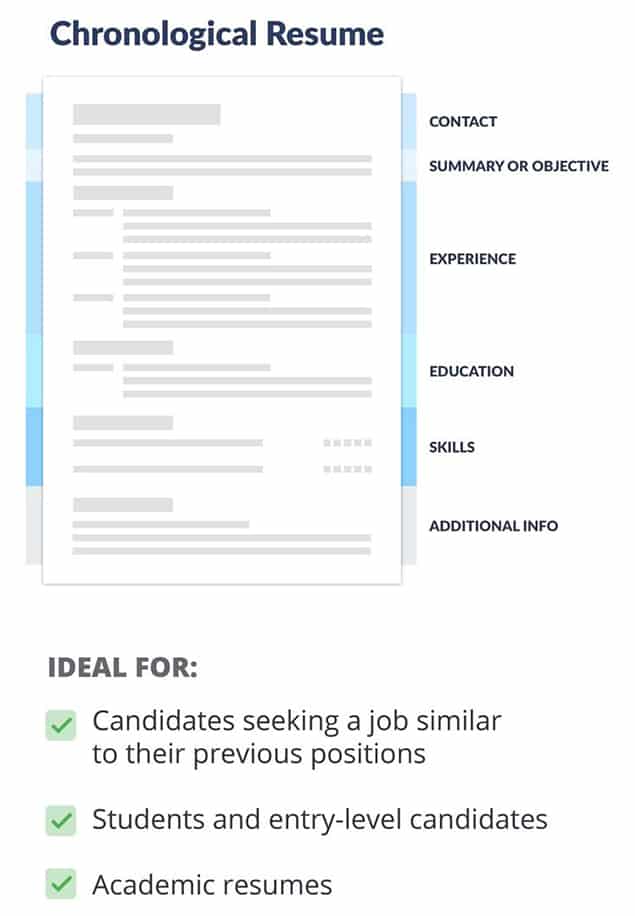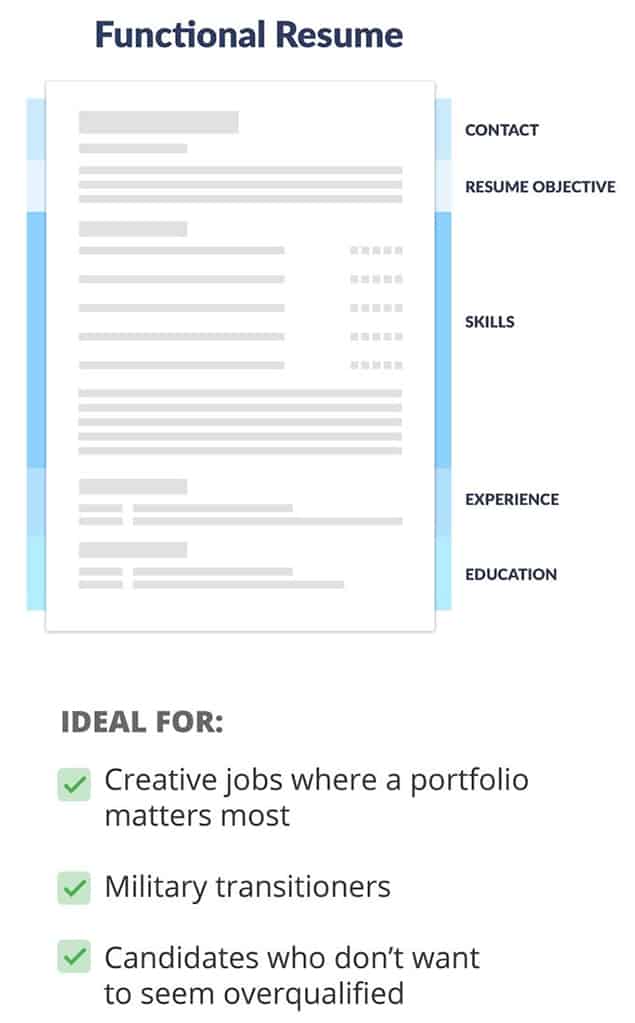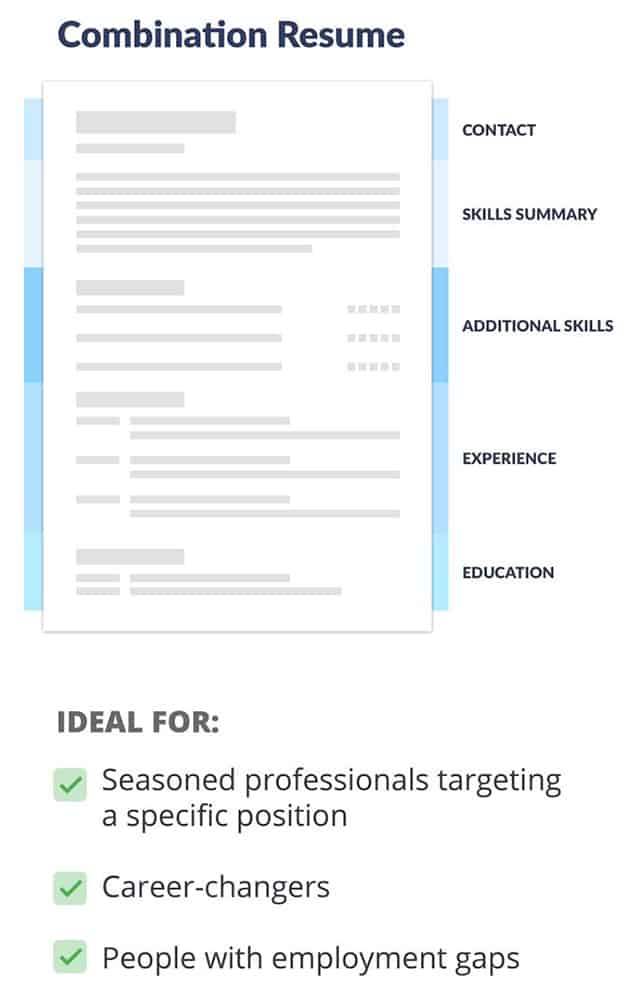Résumé Formats: Which One Makes the Most Sense?
Wednesday | January 31, 2018 | by Uptowork

Have you started writing your first proper résumé but are already stuck? You probably assumed there is one official, proper résumé format, but it turns out there are three. It can be difficult to decide which résumé format makes the most sense for you. In this blog post, you will discover the résumé format options and find out which ones work best for most candidates.
What Résumé Formats Are There?
There are three standard résumé formats:
- Chronological (or rather reverse-chronological)
- Functional (also known as skills-based)
- Combination (also known as hybrid)
One of these résumé formats works best for most people—not just experienced middle management candidates, but also students, recent graduates, and entry-level candidates.
Chronological Résumé Format
The chronological format is the gold standard in recruitment and has been in use for the longest time. Most people call it chronological, but technically it is reverse-chronological. You list your experience with your most recent position up top and work your way back in time listing older and older jobs. So, why is this appropriate for entry-level candidates and future interns? There is not much experience they can list, right? Here is the solution. If you have little to no experience, get some. I know this sounds like a catch-22 situation. (“I need experience to get experience.”) However, almost all employers expect at least some experience even if it is not all that relevant to the job in question.
Internships matter a lot, too. Internship experience is one of the strongest factors that influence decision makers. Even volunteering matters! If you cannot really show off a consistent employment history, do not worry. Employers understand the concept of entry-level jobs. So, here is another solution:
Pro Tip #1: If there is any rule in writing a résumé, it is this: always put your best foot forward.
Move your education section above your work experience section. Share as much relevant information as you can. Below is an example of how a candidate targeting a job at a startup company could do it:
- Bachelor of Commerce (Management Specialist with a concentration in Innovation and Entrepreneurship)
- University of Toronto, expected to graduate in 2018
- Relevant Coursework: Entrepreneurship, The CEO’s Toolkit, Writing Reports, The Business of Software
- Extracurricular Activities: Member of AIESEC Toronto
You want to make the most of your education—do not just list the university and degree. Include more details, such as honors, accolades, as well as relevant coursework and extracurricular activities. The candidate shown above has not graduated yet, but if you have, just say you graduated and give the date.
Pro Tip #2: Some experts argue against disclosing your GPA. However, the closer it is to perfect, the more sense it makes to mention it. Some employers expect you to.
If you really have no work experience, you can include relevant personal or school projects you worked hard on. At this point in life, employers mostly want to see that you are dependable, can work on a team, lead your colleagues, and that you can navigate the work environment. Your work experience section can become a projects and activities section if need be. These two sections are crucial. If you do them right, you are already giving the employer most of what they need since they know your background and what to expect.
Now for the Finishing Touches
Include a skills section. This is where you can list any additional skills you possess and reiterate the skills you mentioned when talking about your education and experience. Do not list too many skills; focus on your strongest abilities. If the list grows too long, employers will not believe it. Include an interests and hobbies section, if relevant. Again, many experts argue against doing so. But that is because they have seen too many résumés that included generic hobbies, such as reading books, listening to music, or travel.
List your hobbies and interests only if they can help you match the company culture. Most employers are on the lookout for a perfect fit—someone who shares their values and attitude. Plus, some hobbies are more than pastime activities. If you wrote for a school journal or run a blog, that makes for a great addition to your projects and activities section.
Pro Tip #3: Do not try to game the system by listing overly job-specific hobbies. If you are trying to land a job as a programmer, do not say that reading books about programming is your hobby. This is implied, and it could look silly on your résumé.
So, now you know how to make a reverse-chronological résumé work to your advantage. You know what sections comprise a chronological template.
What about the other two résumé formats?
Functional Résumé Format
This format got really popular in the nineties. The fact that it is skills-based makes it tempting. If you have little or no experience, why not focus on your abilities? Skills matter most in the end! Not so fast. The problem is that the functional résumé format focuses on skills at the expense of everything else. You do not really talk about the jobs or education you have had, but rather tell the employers what you can do. This makes it even more enticing to people with little or no experience. However, using this résumé format means your application will read like a list of unsubstantiated claims. A braggy wishlist, to be precise.
Remember that candidate from the example above? She would say she has management and leadership skills, is an entrepreneur, and can work on a team…but there would be no proof of that on her résumé. Employers would clearly see through this. They would guess she has only studied these topics, and assume she is out of touch with reality, and move on. If you are early in your career, you simply do not have enough experience to ignore any of it on your résumé.
The functional résumé format might work for candidates targeting jobs in the creative industry where portfolios matter as much as résumés (or even more). However, you can still use a regular chronological résumé and list any projects and freelance work you have done. Unless you have been really prolific outside of class, all these gigs can be easily included in the classic employment history section.
Combination Résumé Format
Can you have your cake and eat it too? The combination résumé format attempts to draw attention to skills while still holding on to your regular work experience. Sounds good, right? Yes, but this is not all that helpful for entry-level candidates and interns-to-be. This résumé template starts with a summary of skills and qualifications. You have learned a lot during your time at university, but not enough to treat this as in-the-trenches experience, or to summarize it. Any attempt to do so will look like a five-minute trailer for a five-minute movie.
Plus, chances are, your résumé will go through an applicant tracking system (ATS), which is a software application that most employers use to sort and classify the many résumés received for any given position. Any non-standard résumé format is a gamble because if the ATS cannot parse it, it will assume your application is non-relevant and move on to the next candidate. Make it your mission to pass the ATS test.
The One Additional Section That Can Make a Difference
Candidates sometimes worry they will not stand out and that their résumé is not catchy enough. Or that the employer will spend just six seconds on their application and move on. What can you do? Include a heading statement. Heading statements are sometimes referred to as professional summaries or career objectives. Although there is a difference between the two, it does not matter. In the end, you simply want to get this personal introduction right.
Here is how you can master the heading statement: Write three to five sentences about who you are, what you can do, and try to show how well you can do it. Although this introduction seems to be about you; in reality, it is more about the employer. Focus on their expectations as expressed in the job listing and show how you have got what it takes to excel at your new job.
Here is an example: A candidate is targeting a job at a startup. She is looking to become a Client Account Specialist. The job clearly states that candidates have to understand how to work in client-facing roles, be tech-savvy enough (a basic understanding of Excel, social media platforms, and technology lingo is required), and know enough about accounting to resolve potential issues with invoicing. Plus, there is the standard expectation that candidates must be able to multitask and think on their feet.
So, she will tailor her résumé to the job description. Here is what she could write in the heading statement:
- Future Bachelor’s of Commerce and Management Specialist expected to graduate in 2018 with a concentration in Innovation and Entrepreneurship. Experience working on a team and leading 3+ projects at the same time (AIESEC Toronto). Looking to boost customer satisfaction at DreamJobs Canada as the Client Account Specialist.
She showed off her relevant education, gave her relevant experience a plug, and did not have to say she can multitask—she proved it (3+ projects at the same time while still studying!) You will not be able to address all the expectations in the heading statement, but that does not matter. You have the whole résumé to do it!
Key Takeaways
It is easy to lose focus and start looking for the next best thing. But there is no need to do so. Stick to the respected, skimmable, and efficient reverse-chronological résumé format. Start with your most solid section (this will be your education section, quite likely). Do not ignore other sections, such as work experience (or projects, volunteer work, internships, or freelancing). Do not forget to provide the employer with a handy list of relevant skills. Show your cultural fit with the right interests and hobbies.
Once you write these sections, add a heading statement up top to provide the decision maker with enough information to make them want to read on. Do you need to go functional? No. Combination? Not really. Stick with the tried and tested chronological résumé and make the most of it by including additional sections.
Related Article
The views and opinions expressed in this article are those of the author(s) and do not necessarily reflect the official policy or position of World Education Services (WES).


